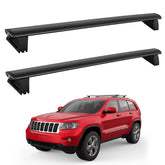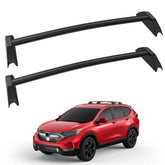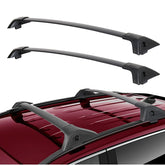How much weight can a roof rack carry?
Roof racks are unsung practical heroes that transform our vehicles into versatile carriers for carrying adventure gear, tools, or extra storage. With them, you can easily stack items on the roof. Note that during use, you need to clearly understand the load-bearing capacity of the roof rack, which will help you use the rack safely and protect your vehicle and your belongings. This article will explain how much weight a roof rack can carry.
How much weight can a car roof rack support?
Before we get to an exact number, we need to mention two key weight ratings of a roof rack‘s “weight capacity” of a roof rack: static weight capacity and dynamic weight capacity.
Static Capacity
This refers to the maximum load that the roof rack can support when the vehicle is stationary. For example, many roof racks can support a roof tent when the vehicle is parked, allowing it to support the weight of the passengers and their belongings. The static capacity will be much higher than the dynamic capacity.
Dynamic Capacity
This represents the maximum weight that the roof rack can safely carry while the vehicle is in motion. Dynamic weight capacity takes into account the forces of acceleration, braking, cornering, and rough terrain. Even moderate weights are multiplied by the forces created by the road. Most roof racks can handle between 50-300 lbs (23-136 kg) while in motion, but this varies by vehicle.

Note
When considering the weight capacity of a roof rack, don't overlook the weight capacity of the roof of your car itself. Each vehicle has a specific roof load rating from the manufacturer. For example, a small sedan will have a lower roof load rating than an SUV or truck designed for heavier loads. This rating includes the weight of the roof rack itself, meaning if your car is rated at 165 pounds and the rack weighs 30 pounds, you'll have about 135 pounds of cargo capacity left. Subtract the total weight of the rack and mounting kit from the manufacturer's stated roof capacity, and the number you're left with is how much weight you can safely carry on your roof.
Factors that affect the load-bearing capacity of a roof rack
When it comes to rooftop luggage, its weight capacity is affected by a variety of factors, which together determine the weight that a roof rack can safely carry. In addition to the most important vehicle roof weight capacity, the following are a few other factors:
Roof Rack Materials
Roof racks are made from a variety of materials, including steel and aluminum, each with different strengths and weights, which determine the strength and sturdiness of the rack. For example, a steel rack has a higher load capacity but is heavier. An aluminum rack will have a lower load capacity than a steel rack, but is lighter and has minimal impact on the car's handling.
Roof Rack Design
In addition, the structure and design of the roof rack will also affect its total load-bearing capacity. A wider, stronger crossbar can carry more weight than a narrow or thin crossbar. A high-quality crossbar has a larger contact surface, which can evenly distribute the weight and thus support more load.

Mounting Style
How a roof rack is attached to the roof of your vehicle can also affect its load-bearing capacity. A properly secured connection ensures optimal load distribution. Here are three common mounting styles:
- Factory-installed roof rails: Some vehicles come with built-in roof rails to support roof rack attachments. These rails provide a sturdy attachment point that is integrated into the vehicle's frame.
- Raised or flush rails: These mounting points provide increased stability and can increase the weight capacity of a roof rack.
- Gutter mounts: For older or heavier vehicles, gutter mounts provide a sturdy anchor point that can support considerable loads.
Weight Distribution
How the load is distributed on your roof rack affects its stability and weight-bearing capacity. The weight of the load should be evenly distributed across the rack, with heavier items placed closer to the mounting points or crossbars. Concentrating the weight in one area can create pressure points, increasing the risk of rack failure.
Temperature and Weather Conditions
Long-term extremes of temperature and weather can affect the quality of the rack material and brackets. For example, prolonged exposure to high temperatures, especially plastic brackets or components, can degrade structural integrity over time, reducing the strength and load-bearing capacity of the rack. Snow and ice can add significant weight to the rack, so be sure to clear the snow before loading to avoid exceeding the rack's load capacity.

Common Uses and Recommended Weight Limits
- Bikes: Most roof racks can carry one to four bikes, each weighing 25-30 pounds
- Kayaks and Canoes: Lightweight kayaks will fit on a roof rack, but heavier kayaks (over 70 pounds) will exceed the dynamic weight limit, especially when paired with additional gear. Canoes are bulkier than kayaks and are a challenge for sedans.
- Rooftop Tents: Rooftop tents are one of the most complicated cases for weight capacity. While their static weight may be within the limit, the tent and passengers will exceed the dynamic capacity when driving.
Practical Tips for Safe Roof Rack Use
Safety is the most important thing when installing and using a roof rack. Here are a few things you need to pay attention to:
Use Tie-Down Straps
Even if your load feels stable, it’s important to always secure it with tie-down straps, which are an essential safety measure. Tie-down straps minimize load shifting and create a strong, cohesive mass that won’t easily slide or fall off.
Avoid Sudden Maneuvers with Heavy Loads
Sudden stops, sharp turns, or evasive maneuvers can be dangerous when carrying a heavy load. A controlled, stable steering style helps to evenly distribute the forces on the roof rack and vehicle.
Regularly Inspect Rack and Mounts
Check your roof rack brackets any time you plan to travel with heavy items. Bolts, clamps, and brackets can loosen over time, and cracks can form around mounting points.

Comply with weight limits
Before loading anything on your roof, always check the roof's load capacity and be careful not to exceed the maximum load limit specified in your vehicle's manual. Overloading can damage your vehicle and even injure pedestrians on the road. Also, make sure the luggage is evenly distributed on the roof rack.
Height restrictions
When you use a roof rack to transport luggage or items, the overall height of your vehicle will also increase. When you need to pass through a low overpass or parking lot entrance, you may not be able to enter due to height restrictions. Therefore, before using a roof rack to transport goods and starting your journey, you can plan your route to avoid the impact of height restrictions.
Conclusion
A roof rack is a valuable addition that allows you to expand the capabilities of your vehicle. Careful loading is essential to maintaining safety, vehicle handling, and structural integrity. With these factors in mind, a roof rack will safely carry your adventures wherever the road leads.
Featured Products
- $83.99
- $83.99
- Unit price
- / per
- $85.99
$138.90- $85.99
- Unit price
- / per
- $69.99
- $69.99
- Unit price
- / per
- $98.99
- $98.99
- Unit price
- / per














